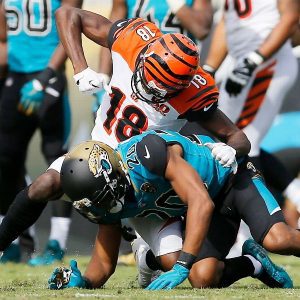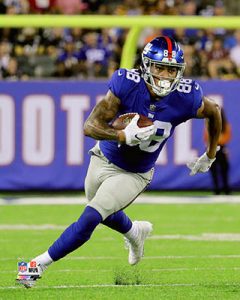Who Were the Best Red Zone Producers in 2017? (#FantasyFootball)
The red zone is where players make their money. This is where box scores are filled. Points are scored. Games are won and lost.
As we discovered a few articles back, a red zone target is worth 2.43 PPR fantasy points and a red zone reception is worth 4.53 PPR fantasy points.
Last week we saw who let their team down in these situations. And some of the names were pretty surprising. This week we’re going to check out who brought home the bacon for their respective squads. While the first few names will be obvious, some might catch your attention.
The primary use of this information is going to be spotting possible regression. Some players may see less red zone volume in 2018, as that isn’t the most sticky metric from year to year. Some might not catch as many touchdowns. And some might surprise us all and perform even better. Let’s find out!
Jimmy Graham
Fantasy points per red zone target: 3.34 (+.91 league average)
Fantasy points per red zone reception: 5.43 (+.9 league average)

 Jimmy Graham is the first name we’re checking out and it should come as no surprise. Graham saw a league-leading 26 red zone targets in Seattle last season. He also caught 16 red zone looks, second to only Jarvis Landry’s 18. He parlayed those 16 receptions into 108 receiving yards and a league-leading 10 touchdowns.
Jimmy Graham is the first name we’re checking out and it should come as no surprise. Graham saw a league-leading 26 red zone targets in Seattle last season. He also caught 16 red zone looks, second to only Jarvis Landry’s 18. He parlayed those 16 receptions into 108 receiving yards and a league-leading 10 touchdowns.
Graham saw this heavy volume because of Seattle’s inept red zone rushing attack. You know, that infamous group of running backs that turned 23 carries inside the 10-yard line into zero yards and zero touchdowns. Graham is changing teams, so volume might be a concern, but his quarterback situation is getting arguably getting better. He has now gone from Drew Brees to Russell Wilson to Aaron Rodgers.
Some may see Graham as an obvious regression candidate, but Rodgers has finished top-5 in red zone pass attempts in 3 of his last 4 healthy seasons. Even if he sees a slight dip in volume, he’ll still command plenty of targets.
Davante Adams
FPPRZT: 3.08 (+.65)
Love our content? Check out the GoingFor2 Live Podcast Network!
FPPRZR: 4.73 (+.2)
Adams remained efficient in the red zone despite catching passes from Brett Hundley for a majority of the season. With Aaron Rodgers returning from injury and Jordy Nelson out of the picture, he lines up as a favorite to lead the NFL in touchdowns.
Adams will be fighting the 6’7” Jimmy Graham for red zone targets this season, but both should see plenty of opportunities. In 2016, Rodgers led the league in red zone pass attempts with 115. Jordy Nelson finished first in red zone targets with 32, while Adams finished third with 23. If Rodgers stays healthy, he can easily support two efficient red zone weapons. And I would be willing to bet Adams will see a bigger piece of that pie, simply because he has a proven rapport with Rodgers.
A.J. Green
FPPRZT: 3.14 (+.71)
FPPRZR: 7.17 (+2.64)
 Despite a down season overall, Green was the same red zone stud that we always knew. He caught seven balls for 71 yards and six touchdowns in the red zone. Green is not a regression candidate to me, as he won’t be seeing much competition for targets in the red zone. Tight end Tyler Eifert hasn’t been healthy since 2015 and nobody else on the team has an imposing frame that would command many targets.
Despite a down season overall, Green was the same red zone stud that we always knew. He caught seven balls for 71 yards and six touchdowns in the red zone. Green is not a regression candidate to me, as he won’t be seeing much competition for targets in the red zone. Tight end Tyler Eifert hasn’t been healthy since 2015 and nobody else on the team has an imposing frame that would command many targets.
If Green bounces back to his old self between the 20s, he could creep back into the top-5 of receivers with his red zone talent. He is a slam-dunk pick in the second round right now.
Amari Cooper
FPPRZT: 2.36 (-.07)
FPPRZR: 7.87 (+3.34)
We have our first regression candidate! And his name is Amari Cooper. Cooper was actually below average on a per-target basis and well above-average on a per-reception basis. This was because he only caught three of his 10 targets and scored three touchdowns on those. A catch rate that low with a touchdown rate that high just screams regression.
Then there are the new receivers in the fold. Oakland signed Jordy Nelson and Martavis Bryant in the offseason. Both figure to see solid red zone volume with their sizes, not to mention the common narrative that Cooper is just bad in the red zone.
The entire Raiders offense could go back to a run-heavy strategy for all parts of the field with Gruden leading the way. This would limit every player in that passing offense, and Cooper would probably be hurt the most. While he should see a bounce back in catches and yards this year, I don’t see his red zone situation getting any better.
Evan Engram
FPPRZT: 4.49 (+2.06)
FPPRZR: 7.06 (+2.53)
 Evan Engram was arguably one of the best rookie tight ends of all time. And his red zone numbers confirmed it. While his overall catch rate of 55 percent left plenty to be desired, that number shot up to 64 percent in the red zone. He collected seven catches for 64 yards and six touchdowns when the Giants were in scoring position. The next best red zone weapon on the team was Sterling Shepard, and we all saw how terrible he was in last week’s article.
Evan Engram was arguably one of the best rookie tight ends of all time. And his red zone numbers confirmed it. While his overall catch rate of 55 percent left plenty to be desired, that number shot up to 64 percent in the red zone. He collected seven catches for 64 yards and six touchdowns when the Giants were in scoring position. The next best red zone weapon on the team was Sterling Shepard, and we all saw how terrible he was in last week’s article.
Engram does show signs of possible regression, but I am cautiously optimistic about his red zone work. While Odell Beckham Jr. is coming back and will likely see the lion’s share of targets down there, Engram still offers the best body archetype for Eli Manning. And he has already proven that he can be useful, and past production is always a good sign. Engram’s size and athleticism should allow him to have a solid touchdown floor in 2018, so another top-5 tight end season is well within reach.
That’s it for this red zone mini-series! Thank you all for reading, I had a lot of fun diving into this data and seeing how some of these big names performed. I will likely be doing something like this midway through the season, so be sure to follow me on Twitter so you don’t miss anything!
ATTN Dynasty Commissioners: Do you want to do something cool for your league? How about a 1-hour live show dedicated to YOUR league? Team-by-team breakdowns, rankings, and more. For details and to book a show, visit: GoingFor2.com/plp.





